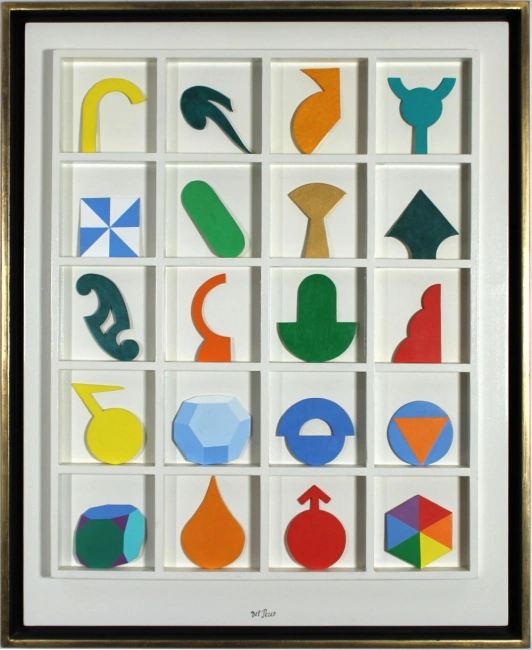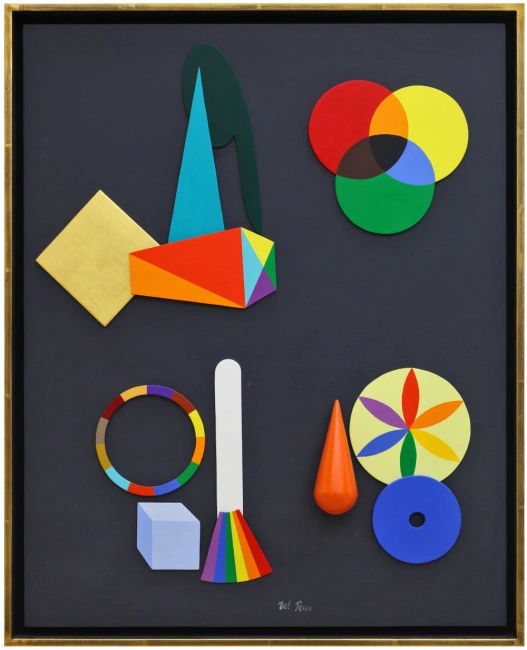Lucio Del Pezzo
Biography
Lucio del Pezzo, Neapolitan by birth (1933) and training, after graduating from the Academy of Fine Arts in Naples, where he is among the founders of Group 58, at the invitation of Enrico Baj, in 1960 he moved to Milan where he held a first solo show at the Schwarz Gallery. Since the 1960s he has been working between Milan and Paris where he lives in Max Ernst's old studio. In 1961, he exhibited in the United States, winning the Carnegie International Award. In 1964 he exhibited at the Milan Triennale and the Venice Biennale, where in 1966 he was invited with a personal room with the presentation of Gillo Dorfles. Lucio Del Pezzo's early works have seen Neapolitan popular culture merge with informal and neo-dadaist experiences. Subsequently he turned to the creation of paintings-sculptures of a neo-metaphysical character in which geometric shapes are flanked by enigmatic references, mythical-ritual, with, however, a focus on the pop language. Notable is the 1974 retrospective at the Rotonda della Besana in Milan curated by Guido Ballo. In 1977 he returned to Milan and also took up the job of set designer, while in 1984 he was awarded the chair of "experimental research on painting" at the New Academy of Fine Arts in Milan. After the great exhibition in Moscow at the 1988 Art Palace and that of the House of Mantegna in Mantua in 1994, in 2000 the Mathildenhe Institute in Darmstadt organized the first retrospective of Lucio Del Pezzo's work in Germany. In Naples in 2001 he performed four large ceramic reliefs and a bronze sculpture for two subway stations and at the same time he organized an anthology exhibition at the Castel del Ovo. In 2008 some works become part of the collection of the Farnesina in Rome. From 1960 to the present day is the exhibition activity of Lucio Del Pezzo both in private galleries and in public spaces as well as the activity of set designer. The elements that make up the art of Lucio Del Pezzo are objects, that is, small wooden sculptures, which he distributes on the surface of the work that is generally a wood. These objects are a solid representation of the artist's memories and cultural interests or the result of his knowledge. For example, the sphere and the circle are symbols of perfection, the triangle is the flat representation of the number three, the number defined perfect by the Pythagorean School of the 1st century BC, the asometric figures are a reference to his passion for drawing. Of course, not all signs are easy to understand, so it is useless to extend it as not everything that any artist lays on the canvas can be explained, perhaps not even by the author. All these objects Lucio Del Pezzo orders them in two strands, that of mensole and that of the casellari. The mensole consist only of a shelf and on this are resting the objects. The background is generally gilded so these works are like lay altars, the background reminding us of the gold bottoms of the Renaissance shovels and the objects the candelabras. The other strand is that of the casellari where Lucio Del Pezzo builds on the bottom table of the wooden squares embossed on the bottom and inside these squares arranges the objects we talked about. Basically the artist intends to sort the boxes his memories as you do with the desktop folders of the computers. Remarkable and rather intense is his resume of exhibitions both in Italy and abroad, in private galleries and in public spaces. In this exhibition panorama, the first solo exhibition in New York in 1961 and that of Paris in 1968 the participation in the 13th triennial in Milan in 1964 where with Baj and Fontana he made "The Labyrinth of Leisure", invitations to the two Venice Biennials, the XXXII of 1964 and the XXXIII of 1966, the latter with a personal room. The last exhibition is done at the Galleria d'Arte L'Incontro of Chiari (BS) Italy from 7 December 2019 to 7 February 2020. Lucio del Pezzo died on April 11, 2020.
Tags: Lucio del Pezzo - del Pezzo - mensole- casellari- Galleria d'Arte L'Incontro
Lucio Del Pezzo - Pop Art
Pop Art,an English abbreviation of the term "popular art", is an artistic current born at the turn of the 1960s in the United States and then spread in Europe, and beyond, in national forms and variations. Pop Art in the United States is nothing more than a reproduction, in ironic and deformed terms, of the symbols of the civilization of consumption, usually advertising of goods of common use or representation of iconic characters, especially of the 60s. In other geographical areas, as in Italy, it takes on a different meaning understood as "art of the people" as it takes its cue from the fascination that classical art exerts on ordinary people and that the artist reinterprets for the benefit of all. Prominent figures were Roy Lichtenstein and Andy Warhol in the United States and Tano Festa and Franco Angeli in Italy

































